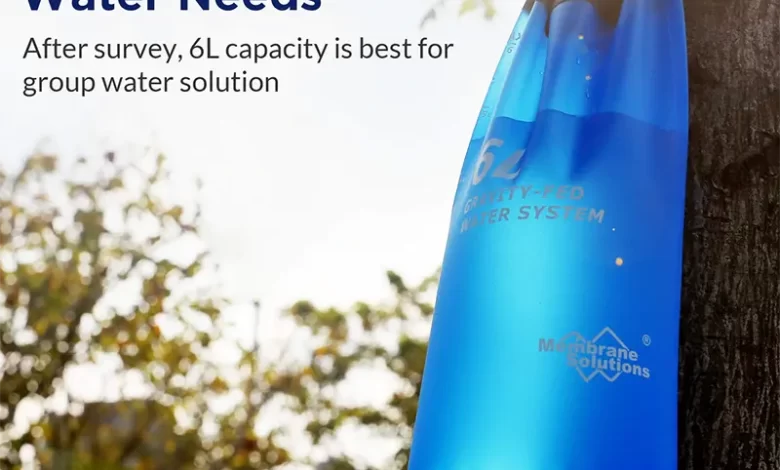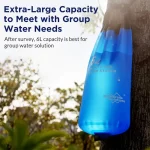
The ability to filter water is essential for most multi-day backpacking trips. The ability to convert natural water sources you encounter (such as rivers and lakes) into clean and safe drinking water allows you to carry less water on most long wilderness trips, effectively reducing the weight of your backpack, a gravity water based purifier is a good choice.
Why do we need a gravity water based purifier?
Even if the water seems perfectly clear, there’s no way to know what’s going on upstream. Perhaps livestock defecated in the middle of a stream, animal carcasses were washed into the water, or a recent rainstorm introduced other harmful substances into the water. So, when backpacking or hiking, you should always use a water filter. It’s easy to get sick from drinking dirty water in the wilderness, and if you get sick while hiking, the consequences can be very serious.
What pollutants does the water purifier filter?
Any water source on Earth can contain harmful waterborne pathogens. In remote areas, even seemingly clear alpine streams can be contaminated by humans, livestock, or local wildlife upstream. Pathogens can multiply rapidly in the body, so ingesting even small amounts can quickly cause problems. The following are the most common waterborne pathogens found in remote areas:
1. Protozoa: Protozoa have hard, sac-like shells that make them resistant to certain generic chemicals, such as chlorine. Fortunately, they’re relatively large, which makes them relatively easy to filter out.
2. Bacteria: including Salmonella, Campylobacter, Escherichia coli, etc. These are just a few of the many different types of bacteria that can be harmful if ingested. Thankfully, too, they are not small in bacteria and are relatively easy to filter out.
3. Viruses: including hepatitis A virus, rotavirus and norovirus. Viruses are much smaller than protozoa and bacteria, making them difficult to filter out. Water filters do not filter the virus, which usually needs to come from a human source (excreta), so in remote areas there is not much chance of the water containing the virus. While the pathogens listed above affect the human body in different ways, the most common symptoms are stomach pain, diarrhea, and vomiting. This can cause extreme dehydration within hours.
Water filter v.s water purifier
Although we often refer to them broadly as “water filters”, there is a very big difference between water filtration and water purification. Water filtration systems remove protozoa and bacteria. Most water filters physically “filter” pathogens using a variety of mechanical methods, such as hollow fiber membranes. Water purification systems remove protozoa, bacteria and viruses. Water purification can be achieved through advanced physical methods such as ion exchange and charcoal filtration, advanced hollow fibers, ultraviolet light, and chemical means.
Why gravity water based purifier more suits for traveling?
In remote areas where the likelihood of human contamination is very low, we usually just use filters. In areas with a high risk of human contamination, such as a slow-flowing water source or a very popular canyon, you may want to consider using a purification system. Also, if you’re hiking in a complex area where safe drinking water is not guaranteed, you’ll definitely need a water purification system.
Types of water purifier
1, extrusion: extrusion filter is made of hollow fiber membrane, usually with a soft bag or water bottle containing dirty water. The water is then squeezed through a filter into a clean bottle, cooker or directly into the mouth. These filters tend to be lightweight, inexpensive, and don’t have to worry about mechanical parts. However, they can decrease the flow rate over time, and for some filters this can be fixed by backblowing.
- Gravity water based purifier: It uses Gravity to pull water from a “dirty” storage bag hanging on a tree (or held high) into a clean bottle through a hollow fiber filter. Such filtration systems tend to be a little heavier than extrusion systems due to water storage bags, lashes, and pipes, but they are a great way to filter large amounts of water with minimal effort and are a great choice for group or base camp camping.
3, pump test: pump filter use manual pump to force water through hollow or glass fiber filter. A hose, many of them with pre-filters, is placed into the water source and pumped by hand until all the water needed is obtained. Unlike other filtration systems, this one requires you to remain at the water source for the duration of the filtration. The pump is also heavier than other filtration systems.
4, ultraviolet lamp: ultraviolet lamp is used to destroy the DNA/RNA of bacteria, protozoa and viruses, so that they can not reproduce and directly kill them. It is essential to pre-filter the water using a bandanna or cloth so that the water is free of particles. While lightweight, UV purifiers rely on batteries (replaceable or USB charging), which backpackers should consider.
5, chemical sterilization: bactericidal drops and tablets and other chemical purifiers contain chlorine dioxide, if given enough time, chlorine dioxide can kill bacteria, protozoa and viruses. Iodine is another chemical treatment available, but it does not kill all protozoa (i.e., Cryptosporidium). Chemical treatments are often used as a backup method, but some people choose to use them as their primary treatment for water.
6, boil sterilization: Boiling water is always a sterilization of choice, can kill bacteria, protozoa and viruses. This may be your best bet if camping in freezing conditions, as many filters cannot be used in icy conditions. If you are using this method, boil water for more than one minute below an altitude of 5,000 meters, or for more than three minutes above an altitude of approximately 5,000 meters (according to EPA data). Make this your main purification method, and be sure to carry excess fuel. To know more on businesslug.
Tips before buying a gravity water based purifier
In addition to different filtration methods, there are many different water filter design features to consider. Some filters are designed to be ultra-light, while others prioritize flow rate, some are used in series with a water bag system, and others are stand-alone units.
- Ease of use: First, when choosing a water filter for backpacking and hiking, it’s important to consider ease of use. If the filter is difficult to use, you may filter less often, thus reducing water use and increasing the risk of dehydration. For individuals, filters that are quick or don’t require much setup are probably easiest to use. For groups, larger capacity gravity filters are more suitable, although the operation is more cumbersome.
- Filtration speed: If you don’t want to waste too much time filtering water, then the speed of filtering water will be an important factor. For squeeze, pump, and gravity filters, be sure to check the “flow rate” to compare the filtration speeds of the various models.
- Weight: Of course, weight has always been a concern for backpackers. There are also plenty of lightweight options for gravity water based purifier, though they often fall a little short in terms of filtration speed, durability, and convenience.
4, service life: the filter has a service life, when buying must understand the filter, especially the use of the filter element time. With many filters, you’ll need to buy a replacement cartridge or completely replace the device at some point.
- Water sources: On a hike, you should know in advance what types of water sources will need to be filtered. Some filters work best in flowing or deeper water sources, while some filters such as pump filters work well in shallow and still water sources.
6, maintenance: many hollow fiber filters, you need to often blow back to maintain its flow rate. If the filter starts to clog, the pump filter may require you to remove the filter element and clean it.
- Interface compatibility: Some filters require a water bottle or water bag to collect water before processing, so you need to consider this when purchasing bottles and water bags to ensure they are compatible with the filter you choose. A good water filtration system is a very important part of backpack equipment, but it is not easy to find the best filtration system. You’ll need to consider the type of water you’ll be hiking and your water needs, and you’ll need to compare and choose between many filter products.
Get to have a full knowing about portable water purifiers on MSPure.







